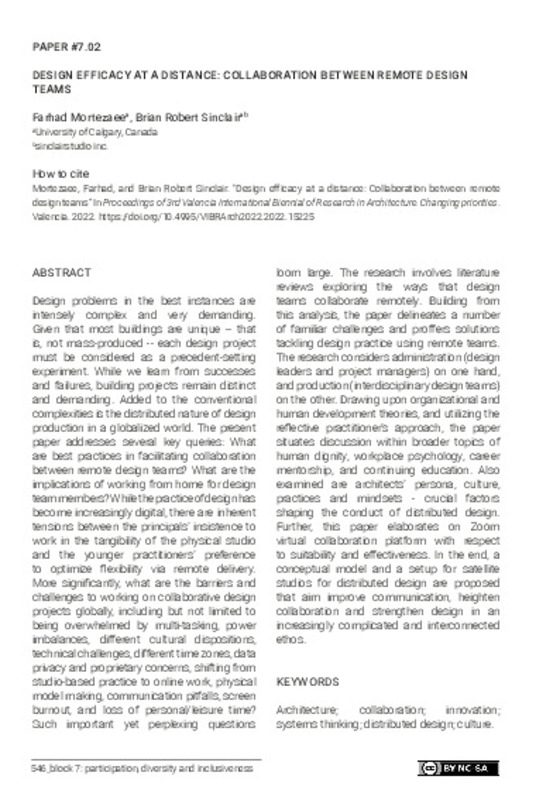JavaScript is disabled for your browser. Some features of this site may not work without it.
Buscar en RiuNet
Listar
Mi cuenta
Estadísticas
Ayuda RiuNet
Admin. UPV
Design efficacy at a distance: Collaboration between remote design teams
Mostrar el registro sencillo del ítem
Ficheros en el ítem
| dc.contributor.author | Mortezaee, Farhad
|
es_ES |
| dc.contributor.author | Sinclair, Brian
|
es_ES |
| dc.date.accessioned | 2023-12-19T08:04:41Z | |
| dc.date.available | 2023-12-19T08:04:41Z | |
| dc.date.issued | 2023-05-22 | |
| dc.identifier.isbn | 9788413960265 | |
| dc.identifier.uri | http://hdl.handle.net/10251/200893 | |
| dc.description.abstract | [EN] Design problems in the best instances are intensely complex and very demanding. Given that most buildings are unique -- that is, not mass-produced -- each design project must be considered as a precedent-setting experiment. While we learn from successes and failures, building projects remain distinct and demanding. Added to the conventional complexities is the distributed nature of design production in a globalized world. The present paper addresses several key queries: What are best practices in facilitating collaboration between remote design teams? What are the implications of working from home for design team members? While the practice of design has become increasingly digital, there are inherent tensions between the principals’ insistence to work in the tangibility of the physical studio and the younger practitioners’ preference to optimize flexibility via remote delivery. More significantly, what are the barriers and challenges to working on collaborative design projects globally, including but not limited to being overwhelmed by multi-tasking, power imbalances, different cultural dispositions, technical challenges, different time zones, data privacy and proprietary concerns, shifting from studio-based practice to online work, physical model making, communication pitfalls, screen burnout, and loss of personal/leisure time? Such important yet perplexing questions loom large. The research involves literature reviews exploring the ways that design teams collaborate remotely. Building from this analysis, the paper delineates a number of familiar challenges and proffers solutions tackling design practice using remote teams. The research considers administration (design leaders and project managers) on one hand, and production (interdisciplinary design teams) on the other. Drawing upon organizational and human development theories, and utilizing the reflective practitioner’s approach, the paper situates discussion within broader topics of human dignity, workplace psychology, career mentorship, and continuing education. Also examined are architects’ persona, culture, practices and mindsets - crucial factors shaping the conduct of distributed design. Further, this paper elaborates on Zoom virtual collaboration platform with respect to suitability and effectiveness. In the end, a conceptual model and a setup for satellite studios for distributed design are proposed that aim improve communication, heighten collaboration and strengthen design in an increasingly complicated and interconnected ethos. | es_ES |
| dc.format.extent | 12 | es_ES |
| dc.language | Inglés | es_ES |
| dc.publisher | Editorial Universitat Politècnica de València | es_ES |
| dc.relation.ispartof | Proceedings - 3rd Valencia International Biennial of Research in Architecture, VIBRArch | |
| dc.rights | Reconocimiento - No comercial - Compartir igual (by-nc-sa) | es_ES |
| dc.subject | Architecture | es_ES |
| dc.subject | Collaboration | es_ES |
| dc.subject | Innovation | es_ES |
| dc.subject | Systems thinking | es_ES |
| dc.subject | Distributed design | es_ES |
| dc.subject | Culture | es_ES |
| dc.title | Design efficacy at a distance: Collaboration between remote design teams | es_ES |
| dc.type | Capítulo de libro | es_ES |
| dc.type | Comunicación en congreso | es_ES |
| dc.identifier.doi | 10.4995/VIBRArch2022.2022.15225 | |
| dc.rights.accessRights | Abierto | es_ES |
| dc.description.bibliographicCitation | Mortezaee, F.; Sinclair, B. (2023). Design efficacy at a distance: Collaboration between remote design teams. Editorial Universitat Politècnica de València. 546-557. https://doi.org/10.4995/VIBRArch2022.2022.15225 | es_ES |
| dc.description.accrualMethod | OCS | es_ES |
| dc.relation.conferencename | 3rd Valencia International Biennial of Research in Architecture, VIBRArch | es_ES |
| dc.relation.conferencedate | Noviembre 09-11, 2022 | es_ES |
| dc.relation.conferenceplace | Valencia, España | es_ES |
| dc.relation.publisherversion | http://ocs.editorial.upv.es/index.php/VIBRArch/VIBRArch2022/paper/view/15225 | es_ES |
| dc.description.upvformatpinicio | 546 | es_ES |
| dc.description.upvformatpfin | 557 | es_ES |
| dc.type.version | info:eu-repo/semantics/publishedVersion | es_ES |
| dc.relation.pasarela | OCS\15225 | es_ES |








